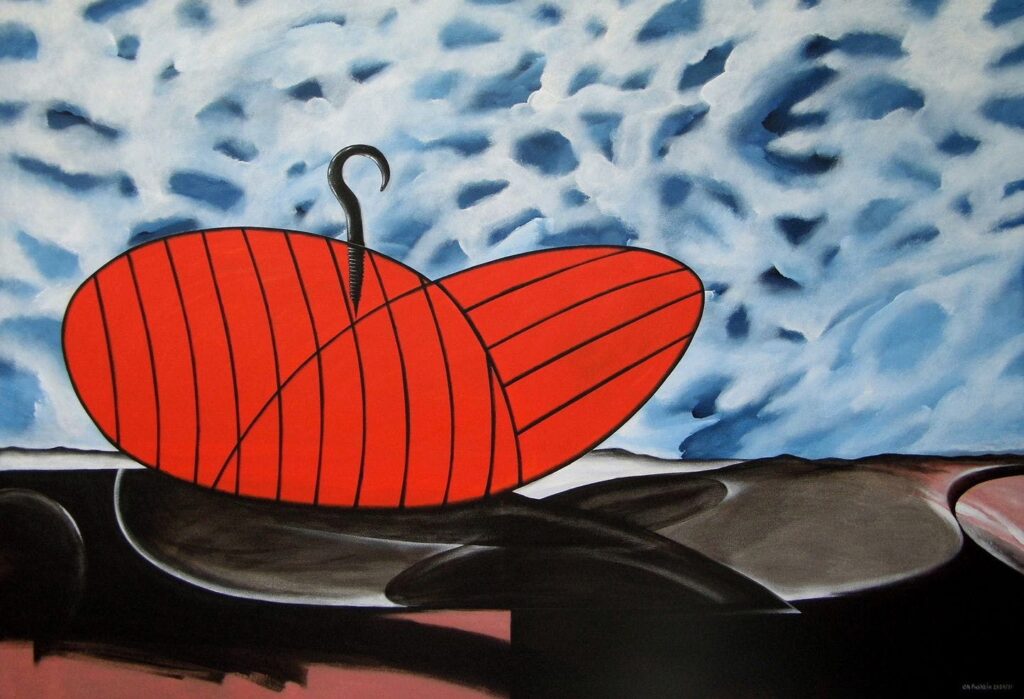EH Pushkin’s distinct visual style rebels with the burden of representation.
What strikes one immediately about Pushkin’s paintings and artworks on show at ‘Lokame Tharavadu’ is a certain unbearable ‘light’ness in them. It is a lightness that is figural, conceptual and metaphorical, one that seems to arise from the vibrancy of colours, and the free, anarchic combination of shapes, objects, figures and patterns. There is nothing vague or fuzzy about these works: though they are abstract and non-representational, they are painted, shaped, moulded and juxtaposed in a stark and unrelenting manner. He prefers primary colours and distinct shapes; his brushstrokes are full and bold, patterns are vivid, and layering – of colour, shapes, figures, grounds – distinct.
These images radiate a very deep and keen feeling for the world in all its chaotic plurality; at the same time, they are also animated with a yearning for something elemental, seeking certain tranquillity or coherence as it were.
This vital yet tenuous connect between the unruly passions and chaos within and the striving for order and patterns without, find uncanny expressions in juxtapositions – of colour, its densities and tonalities, of objects – natural and manufactured, plain and coloured, imaginary and found, and figures – realistic, surreal and spectral.
Here effects of planes and dimensions, depth and density merge, transform and transfigure into one another to create strange effects. Many of these works play with lines and surfaces, depth and flatness, and also materials and concepts; it brings to the surface the ‘work’ of art, the methods (acts and modes) of making and ideas (metaphoric associations) that spur them.
The play with empirical dimensionalities – of physical nature and dimension of things, perspectives and the way in which they are figured – resonates with Pushkin’s vision of life that is pervaded with a deeply reflective sense of the endless processes of becoming – one that enfolds the material, conceptual and emotional.
In the painting ‘An Extreme Concept Waiting for Airlift’, an all-too ‘real’ hook pierces a flat, all-too plain, painted red surface; these images in the midground, are placed against a heavily painted skyscape and a dark-brownish ladle-like objects in the foreground. In the painting ‘Future concept of an art gallery for every human being’ too we see these different dimensions, planes and visual effects at work: of the bluish-hazy skyscape in the background, the line-drawn, three-dimensional ‘box’ in the middle and the dark brownish ‘hard’ surface of the foreground.
Here, the magical object in the middle seems to teeter between different worlds and states of being – earth and sky, the real and spectral, flatness and depth, physical and conceptual. Paintings like ‘Old Man Crossing a Landscape named ‘Remembrance’, ‘Future Concept of a Theatre for Every Actor’, and ‘Young Man Crossing a Picture of an Enormous Tree Bathed in Moonlight’ belong to the same thematic and stylistic series. In a painting like ‘A Single line, Drawn by an Artist Terribly Intertwined between Two Exits’, such playful tension is at work both vertically between planes, and horizontally between figures.
While the skyscape and earthscape are neatly divided vertically, the red and green ‘arcs’ and the endless doodles of the artist entwined in the middle extend horizontally across the canvas. The titles of the painting – Pushkin being a poet and storyteller – themselves add additional dimensions of written words and narratives to the exhibits, reflecting back and forth from each other – prompting the viewer to journey through, across and between images, words and concepts.
The installed objects (rather than sculptures) have this quality of being ‘real’ and enigmatic at the same time; they are found objects like a broken spade, fallen wooden twigs, logs, utensils etc – that have been painted, joined, shaped and juxtaposed. They seem to lure our reflective gaze towards them, in a way, exposing and explicating the process of art-making, and the magic of aesthetic pleasure.
Another series consists of a group of ‘studies’ painted in white background – of figures that evoke certain apparitions, hazy emergences, shades and patterns. These sets of paintings, drawings, studies and installations together complement and converse in curious ways, which is something that any thoughtful act of display intends to invoke or invite.
Pushkin is one artist who has constantly explored and experimented with his tools, materials, methods, techniques and themes. From his ‘radical’ days of yore, he has journeyed hard and long to create a distinct visual style and language of his own, one that is shorn of all ornamentations and burdens of representation.
Certain unbearable lightness of being and becoming pervade his contemporary works. They invite the viewer to look at the world and life through them and experience their multidimensionality and endless possibilities of transformation inherent in the interface between the artist and the world, materials and ideas, figures and concepts and also art and the viewer.

